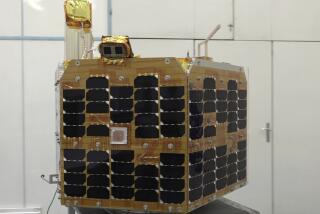German Official Lauds Results as Shuttle Lands
- Share via
EDWARDS AIR FORCE BASE, Calif. — The space shuttle Challenger descended out of a clear blue sky and landed in a dense desert haze Wednesday, capping a seven-day flight that marked a new era in international cooperation in space.
Twin sonic booms announced the end of the mission, the first manned space flight in history with a payload controlled by a country other than the United States or the Soviet Union. The European-built Spacelab aboard the Challenger was commanded by a German control center near Munich, although operational control of the shuttle remained with the Johnson Space Center in Houston.
“It was a very good success, a beautiful mission,” Herman Strub of the West German space agency said after the landing. West Germany paid the National Aeronautics and Space Administration about $64 million to charter the shuttle to carry the $1-billion Spacelab.
Victory for NASA
Strub and other European officials said the success of the flight should help pave the way for broader participation by European governments in what is becoming an increasingly international space program. That would be a special victory for NASA, which is hoping for multibillion-dollar investments by foreign countries in its planned space station. West Germany would be the largest investor in a $2-billion component that NASA hopes Europe will supply for the permanent orbiting laboratory.
“We hope this mission will help us do so,” Strub said in a press conference here.
As the crew prepared for the landing Wednesday morning, Mission Control in Houston warned that Southern California’s weather would be sunny, but a bit thick.
Challenger commander Henry W. Hartsfield was told that not a cloud could be seen within “about 300 miles” of the desert runway. But he was warned to expect visibility to drop to “about five miles or so” after punching into a brown blanket of air that covered the dirt runway.
A Perfect Landing
Hartsfield and pilot Steven R. Nagel brought the giant glider in for a perfect landing at 9:45 a.m., ending a seven-day mission for a record crew of eight. He also tried out a new nose-wheel steering system that may make it possible for NASA to resume landing shuttles at the Florida spaceport as early as December.
The international crew, which included three European scientists, finished 75 of 76 experiments while orbiting the Earth 111 times. The crew included Ernst Messerschmid and Reinhard Furrer of West Germany, Wubbo Ockels of the Netherlands, and NASA crew members Bonnie J. Dunbar, James F. Buchli and Guion S. Bluford.
More to Read
Sign up for Essential California
The most important California stories and recommendations in your inbox every morning.
You may occasionally receive promotional content from the Los Angeles Times.













